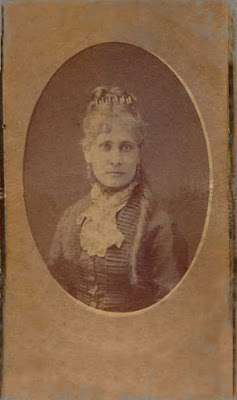In this poem about a family fishing excursion Belle Tisdale paints a vivid picture of a trip to the Amite by the Pratt, Tisdale, Craig, and other families. The winding Amite River, pronounced A-meet in Louisiana, flows south just a few miles east of the Pratt farm. It is still a popular fishing place today.
There is no date on the page but the ink handwriting matches Belle's letter of April 27, 1869, in which she writes "...we intend to go to the Amite next Friday to stay all night and all next day and come home late in the evening; ..."
[Original,
7 3/4" x 9 3/4" paper, written in ink on both sides of the page.
There is an imprint in top left corner, the word “CONGRESS” with
a domed building. Transcribed as written.]
On
our fishing excursion
Twas
early in the morn we started,
On
that gay and happy tour;
All
of us were merry hearted,
But
of that you will feel sure,
When
I tell you all that happened,
From
the time we left our door.
The
Sun had set, when all drew near;
The
tent and two large fires,
Uncle
Jenie, Uncle Emm,
My
sister and my cousin,
Were
seated on an old dead tree,
Which
near our camp had fallen.
Now
at a loss for what to do,
We
thought we'd have some fun;
Some
one says, suppose we dance!
No
sooner said than done,
We
yelled and whooped & shouted: Jack!
Till
he came and danced on the wagon back, which served us as a floor.
Next
came Frank who danced so light,
You
could scarcely see him move;
Then
Henry, well! To look at him,
Would
be to much for you.
After
that they sung some songs,
Which
were funny to be sure,
We
had no solemn things with us,
They
are to much of a boor.
Then
all retired for the night,
Except
Eugene and George,
They
rowed down to their set lines,
And
found they'd caught two gars.
By
Belle.
Many
years later Belle's younger brother Robert Tisdale reminisced about
the trips to the Amite in a letter he wrote to Belle in 1929:
"...I
would like to get a drink of water from the blue spring that comes
out from under a big tree on the edge of the ravine. Lining the edge
of the ravine just back of where we built the house was where the
Federal troops built their dutch ovens in the ground when they went
out there in 1878 to get away from Yellow Fever, and around the base
of the big tree up on the bluff on the other side of the ravine was
where the path wound that led to the Amite; it came out under the
beech trees where we used to camp when Grandpa and Uncle Genie and
you and all of us, went out there on our fishing trips. I can call up
in my mind right now just how it all looked both in summer and in
winter."
I
can call it up in my mind, too, the golden sun sinking into the
shadowy trees along the Amite River. I can almost smell the crackling
fires and hear the buzz of the locusts. The beech trees and the
moss-draped oaks and the sweet-smelling magnolias would cast long shadows
toward the wagon. The first weekend in May would have been a pleasant
time in south Louisiana for a camping trip, not too hot yet and not
many bugs.
Belle mentions Uncle Jenie, Joel Eugene Pratt, and Uncle Emm, Emmett Craig, cousin Kate's father, as well as her sisters and brothers. Belle and Mary sit on a fallen tree with Uncle Jenie and Uncle Emm and watch the campfires after sunset. Perhaps little Lee and Robert sat in their laps while brothers Frank and Willie gathered fallen branches to feed the fire...a timeless scene easy for any camper to picture.
It would have been a time to forget about the turmoil of reconstruction and the problems that were separating Belle's family.













